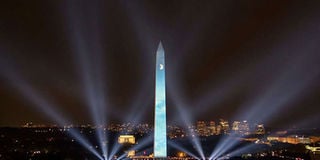Breaking News: At least 10 feared to have drowned in Makueni river
Let us borrow from Apollo 11 legacy

This handout photo released by NASA shows the 50 year anniversary of the Apollo 11 mission being celebrated in the "Apollo 50: Go for the Moon" show on July 19, 2019 in Washington, DC. The space programme gave the US an emphatic head start in computer science. PHOTO | BILL INGALLS | AFP
What you need to know:
- The Apollo project resulted in a raft of innovations that still define the state of the art in the areas of renewable energy, material science medicine and nutrition.
- Kenya can derive several lessons from Project Apollo. Manufacturing is a sure way to create jobs and improve the quality of life for many.
July has important dates on humankind’s space calendar.
July 20, 2019 marked the 50th anniversary of the first manned moon landing in 1969. July 11 was the 40th year since the destruction of the space station ‘Skylab’, another manned adventure, on its fall back to earth a decade later.
Nothing defines the accomplishments of the Kennedy presidency as the images of the first human beings walking, seemingly cavorting, on the Moon.
Neil Armstrong had made his first tentative steps on the Moon and declared: “This is a small step for a man but a giant leap for mankind.”
However, the flag that he planted on the hard lunar surface was not the blue one of the United Nations but the ‘Stars and Stripes’. USA had ‘won’ the space race!
SPACE RACE
When the three moon-faring astronauts splashed down on the Atlantic on their return to earth on July 24, they were welcomed by President Richard Nixon. John F. Kennedy had been dead for six years, having served for under three years.
The space race had intensified 10 years earlier when the Soviet Union launched the first satellite around the earth — the Sputnik I — on October 4, 1957.
They soon after made the dog Laika the first animal to orbit the earth on November 3, 1957. But, the icing on the cake was the April 12, 1961 first orbiting of Earth by man — air force test pilot Yuri Gagarin.
US President Dwight Eisenhower then established Nasa to respond to the technological hegemony being framed in military and security terms.
The space programme survived Kennedy’s reign, culminating in the moon landing. The manned US space missions evolved from Project Mercury through Project Gemini to Project Apollo, ending with Project Skylab.
KENNEDY'S FEAT
But, it was Kennedy’s rhetoric during the ‘space race’ that forever linked his name with the space programme.
Even before running for office, he had raised his voice on the ‘missile gap’ between the US and USSR. He did not wait until after the presidential elections of 1960 (against then-Vice-President Nixon).
Freshly elected JFK first proposed the Moon target as a national goal in 1961 in a speech to Congress and later reiterated and clarified the challenge his nation faced in an eloquent speech at Rice University in 1962: “But why, some say, the Moon?”
The singular spectacular achievement forgave the shortcomings and failures in other goals and gave credit to Kennedy for being the ‘spiritual leader’ of the space race.
Sure, there were several other important issues the American society faced: the civil rights movement, feminism, the Bay of Pigs, the Cuban missile crisis....
DIVIDENDS
The manned space programme has its own legacy. It was expensive: 400,000 people worked on it at its peak; it required the support of 20,000 industrial firms and universities; and it cost $200-300 billion (today’s money).
The legacy of the space race continues to pay dividends to the US economy. The first major one is technological.
The dominance of US in aeronautics is seen by the ubiquity of its aviation products in airliners like Boeing, general aviation aircraft like Cessna and all kinds of military aircraft, manned and unmanned.
The Apollo project also resulted in a raft of innovations that still define the state of the art in the areas of renewable energy, material science medicine and nutrition.
The solar panels used in calculators and street lights are a direct result of the space programme. Technologies for water purification developed from the Apollo purification system are widely used.
USA'S EDGE
Nasa maintains a database of the spinoffs of its programmes and publishes them in Spinoff, in which over 2,000 products have been profiled.
The space programme gave the US an emphatic head start in computer science and robotics only being challenged now.
Kenya can derive several lessons from Project Apollo. Manufacturing is a sure way to create jobs and improve the quality of life for many.
The aerospace industry is a good place to start; there are several other legitimate industries and the industry is evolving fast. Unmanned Aerial Systems are a new economy industry.
Manufacture and operation of drones provide a low-entry barrier into aeronautics and robotics.
Big dreams require focus and dedication. The Apollo programme initially faced opposition from many Americans, who derisively referred to it as a ‘moondoggle’ — a project considered a waste of time and money but continued due to extraneous policy or political motivations.
Despite all this, the yet-to-be-matched manned moon landing stamped on the human psyche the enduring view of USA as the undisputed leader in science and technology.
Mr Odido is a lecturer in the School of Aerospace Sciences, Moi University. [email protected]





